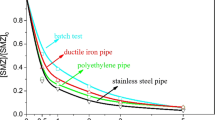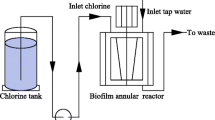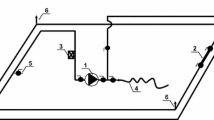Abstract
In this study, the influence of pipe materials on chlorine decay, trihalomethanes formation, as well as on microbial community composition of the biofilms formed on the pipe walls in a model full-scale water distribution system was investigated. The chlorine decay experiment showed that the turbulent flow model fitted the experiment data of chlorine decay well, with stainless steel pipe that had the highest rate constant of chlorine decay, and followed by ductile iron pipe and polyethylene pipe. Meanwhile, the formation of trihalomethanes under the three different pipe materials followed the order as: polyethylene pipe > ductile iron pipe > stainless steel pipe. Microbial community analysis showed that biofilm from polyethylene pipe had much higher diversity than that from the ductile iron pipe and stainless steel pipe. In addition, clear differences in the bacterial community structure among biofilms of different pipe materials were observed. The ductile iron pipe biofilm was mainly composed of Enhydrobacter (33.84%), Propionibacterium (8.08%) and Acinetobacter (5.59%). The polyethylene pipe biofilm contained Sphingomonas (25.25%), Streptococcus (7.64%), Ralstonia (4.83%), Pseudomonas (4.63%), and Escherichia–Shigella (4.71%). The stainless steel pipe biofilm was abundant with Flavobacterium (24.76%), Arcicella (12.03%), and Acidovorax (8.98%). Moreover, the occurrence of opportunistic pathogens was detected, especially in the biofilm of polyethylene pipe, followed by ductile iron pipe and stainless steel pipe. The integrated findings in this study suggest that ductile iron pipe and stainless steel pipe are more suitable as plumbing material than polyethylene pipe in drinking water distribution systems.
Graphical Abstract






Similar content being viewed by others
References
Al-Jasser AO (2007) Chlorine decay in drinking-water transmission and distribution systems: pipe service age effect. Water Res 41:387–396
Ammendolia MG, Bertuccini L, Minelli F, Meschini S, Baldassarri L (2004) A Sphingomonas bacterium interacting with epithelial cells. Res Microbiol 155:636–646
AWWARF (1996) Characterisation and modeling of chlorine decay in distribution systems. In: AWWA (ed). USA
Bois F (1997) Dynamic modeling of bacteria in a pilot drinking-water distribution system. Water Res 31:3146–3156
Chao A (1984) Nonparametric-estimation of the number of classes in a population. Scand J Stat 11:265–270
Clark RM (1998) Chlorine demand and TTHM formation kinetics: a second-order model. J Environ Eng 124:16–24
Clark RM, Sivaganesan M (2002) Predicting chlorine residuals in drinking water:second order model. J Water Resour Manage 128:152–161
Clark RM, Rossman LA, Wymer LJ (1995) Modeling distribution system water quality: regulatory implications. J Water Resour Manage 121:423–428
Edgar RC (2010) Search and clustering orders of magnitude faster than BLAST. Bioinformatics 26:2460–2461
Elsheamy K (2000) Simulation of THM species in water distribution systems. Science 34:3431–3439
Fang H, West JR, Barker RA, Forster CF (1999) Modelling of chlorine decay in municipal water supplies. Water Res 33:2735–2746
Felföldi T, Heeger Z, Vargha M, Marialigeti K (2010) Detection of potentially pathogenic bacteria in the drinking water distribution system of a hospital in Hungary. Clin Microbiol Infect 16:89–92
Gauthier V, Redercher S, Block J-C (1999) Chlorine inactivation of sphingomonas cells attached to goethite particles in drinking water. Appl Environ Microbiol 65:355–357
Hallam NB, West JR, Forster CF, Powell JC, Spencer I (2002) The decay of chlorine associated with the pipe wall in water distribution systems. Water Res 36:3479–3488
Hammes F, Berney M, Wang Y, Vital M, Köster O, Egli T (2008) Flow-cytometric total bacterial cell counts as a descriptive microbiological parameter for drinking water treatment processes. Water Res 42:269–277
Holinger EP, Ross KA, Robertson CE, Stevens MJ, Harris JK, Pace NR (2014) Molecular analysis of point-of-use municipal drinking water microbiology. Water Res 49:225–235
Hong PY, Hwang C, Ling F, Andersen GL, LeChevallier MW, Liu W-T (2010) Pyrosequencing analysis of bacterial biofilm communities in water meters of a drinking water distribution system. Appl Environ Microbiol 76:5631–5635
Inkinen J, Kaunisto T, Pursiainen A, Miettinen IT, Kusnetsou J, Riihinen K, Keinanen-Toivola MM (2014) Drinking water quality and formation of biofilms in an office building during its first year of operation, a full scale study. Water Res 49:83–91
Jenkins O, Byrom D, Jones D (1987) Methylophilus: a new genus of methanol-utilizing bacteria. Int J Syst Bacteriol 37:446–448
Kelly JJ, Minalt N, Culotti A, Pryor M, Packman A (2014) Temporal Variations in the Abundance and composition of biofilm communities colonizing drinking water distribution pipes. PLoS One 9:e98542
Koskinen R, Ali-Vehmas T, Kämpfer P, Laurikkala M, Tsitko I, Kostyal E, Atroshi F, Salkinoja-Salonen M (2000) Characterization of Sphingomonas isolates from Finnish and Swedish drinking water distribution systems. J Appl Microbiol 89:687–696
La Rossman (2006) The effect of advanced treatment on chlorine decay in metallic pipes. Water Res 40:2493–2502
Lee J, Lee C, Hugunin K, Maute C, Dysko R (2010) Bacteria from drinking water supply and their fate in gastrointestinal tracts of germ-free mice: a phylogenetic comparison study. Water Res 44:5050–5058
Lehtola MJ et al (2004) Microbiology, chemistry and biofilm development in a pilot drinking water distribution system with copper and plastic pipes. Water Res 38:3769–3779
Liu R, Yu Z, Zhang H, Yang M, Shi B, Liu X (2012) Diversity of bacteria and mycobacteria in biofilms of two urban drinking water distribution systems. Can J Microbiol 58:261–270
Liu G et al (2014a) Pyrosequencing reveals bacterial communities in unchlorinated drinking water distribution system: an integral study of bulk water, suspended solids, loose deposits, and pipe wall biofilm. Environ Sci Technol 48:5467–5476
Liu R, Zhu J, Yu Z, Joshi D, Zhang H, Lin W, Yang M (2014b) Molecular analysis of long-term biofilm formation on PVC and cast iron surfaces in drinking water distribution system. J Environ Sci 26:865–874
Lohse M, Bolger AM, Nagel A, Fernie AR, Lunn JE, Stitt M, Usadel B (2012) RobiNA: a user-friendly, integrated software solution for RNA-Seq-based transcriptomics. Nucleic Acids Res 40:W622–W627
Mi Z, Dai Y, Xie S, Chen C, Zhang X (2015) Impact of disinfection on drinking water biofilm bacterial community. J Environ Sci 37:200–205
Moritz MM, Flemming H-C, Wingender J (2010) Integration of Pseudomonas aeruginosa and Legionella pneumophila in drinking water biofilms grown on domestic plumbing materials. Int J Hyg Environ Health 213:190–197
Niquette P, Servais P, Savoir R (2000) Impacts of pipe materials on densities of fixed bacterial biomass in a drinking water distribution system. Water Res 34:1952–1956
Paula V, Sérgio TC, Dália L (2004) Accounting for the influence of initial chlorine concentration, TOC, iron and temperature when modelling chlorine decay in water supply. J Water Supply Res T 53:453–467
Qualls RG, Johnson JD (1983) Kinetics of short-term consumption of chlorine by fulvic acid. J Environ Sci Technol 17:692–698
Rogers J, Dowsett A, Dennis P, Lee J, Keevil C (1994) Influence of plumbing materials on biofilm formation and growth of Legionella pneumophila in potable water systems. Appl Environ Microbiol 60:1842–1851
Schloss PD, Westcott SL, Ryabin T, Hall JR, Hartmann M, Hollister EB, Lesniewski RA, Oakley BB, Parks DH, Robinson CJ, Sahl JW, Stres B, Thallinger GG, Horn SJV, Weber CF (2009) Introducing mothur: open-source, platform-independent, community-supported software for describing and comparing microbial communities. Appl Environ Microb 75:7537–7541
Shannon CE, Weaver W (1949) The mathematical theory of communication. University of Illinois Press, Urbana
Shaw JLA, Monis P, Weyrich LS, Sawade E, Drikas M, Cooper AJ (2015) Using amplicon sequencing to characterize and monitor bacterial diversity in drinking water distribution systems. Appl Environ Microb 81:6463–6473
Standards of The People’s Republic of China (2006) In Standards for drinking water quality, China. GB 5749–2006
Sun W, Liu W, Cui L, Zhang M, Wang B (2013) Characterization and identification of a chlorine-resistant bacterium, Sphingomonas TS001, from a model drinking water distribution system. Sci Total Environ 458:169–175
Thomas JM, Ashbolt NJ (2010) Do free-living amoebae in treated drinking water systems present an emerging health risk? Environ Sci Technol 45:860–869
Van der Kooij D, Veenendaal HR, Scheffer WJ (2005) Biofilm formation and multiplication of Legionella in a model warm water system with pipes of copper, stainless steel and cross-linked polyethylene. Water Res 39:2789–2798
Wang Q, Garrity GM, Tiedje JM, Cole JR (2007) Naive Bayesian classifier for rapid assignment of rRNA sequences into the new bacterial taxonomy. Appl Environ Microbiol 73:5261–5267
Wang H, Masters S, Hong Y, Stallings J, Falkinham JO III, Edwards MA, Pruden A (2012) Effect of disinfectant, water age, and pipe material on occurrence and persistence of Legionella, mycobacteria, Pseudomonas aeruginosa, and two amoebas. Environ Sci Technol 46:11566–11574
Wang H, Masters S, Edwards MA, Falkinham JO, Pruden A (2014) Effect of disinfectant, water age, and pipe materials on bacterial and eukaryotic community structure in drinking water biofilm. Environ Sci Technol 48:1426–1435
Wang H, Masters S, Falkinham JOIII, Edwards MA, Pruden A (2015) Distribution system water quality affects responses of opportunistic pathogen gene markers in household water heaters. Environ Sci Technol 49:8416–8424
White DC, Sutton SD, Ringelberg DB (1996) The genus Sphingomonas: physiology and ecology. Curr Opin Biotech 7:301–306
Wingender J, Flemming H-C (2011) Biofilms in drinking water and their role as reservoir for pathogens. Int J Hyg Environ Health 214:417–423
Yang YJ, Goodrich JA, Clark RM, Li SY (2008) Modeling and testing of reactive contaminant transport in drinking water pipes: chlorine response and implications for online contaminant detection. Water Res 42:1397–1412
Yu J, Kim D, Lee T (2010) Microbial diversity in biofilms on water distribution pipes of different materials. Water Sci Technol 61(1):163–171
Zhang P, LaPara TM, Goslan EH, Xie Y, Parsons SA, Hozalski RM (2009) Biodegradation of haloacetic acids by bacterial isolates and enrichment cultures from drinking water systems. Environ Sci Technol 43:3169–3175
Acknowledgements
This study was supported by the National Natural Science Foundation of China (No.51578487), Zhejiang Provincial Natural Science Foundation of China (No. Y15E080016), the National Major Program on Pollution Control and Management of Water Body (Grant No. 2012ZX07403-003) and China Scholarship Council Foundation.
Author information
Authors and Affiliations
Corresponding author
Additional information
Editorial responsibility: M. Abbaspour.
Electronic supplementary material
Below is the link to the electronic supplementary material.
Rights and permissions
About this article
Cite this article
Zhang, C., Li, C., Zheng, X. et al. Effect of pipe materials on chlorine decay, trihalomethanes formation, and bacterial communities in pilot-scale water distribution systems. Int. J. Environ. Sci. Technol. 14, 85–94 (2017). https://doi.org/10.1007/s13762-016-1104-2
Received:
Revised:
Accepted:
Published:
Issue Date:
DOI: https://doi.org/10.1007/s13762-016-1104-2




